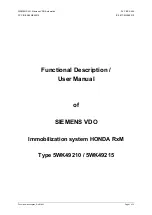
The remote fault LED will blink the set sensitivity of the detector. The
number of blinks, similar to number of blinks from the arrows, will represent
the set sensitivity and the sequence is repeated every 3 seconds till the
detector is reset.
The LEDs at the remote test station will mimic the detector front LEDs.
Note:
For the OSI-RIE-xx this test does not satisfy the requirements
of NFPA72 for periodic maintenance and sensitivity verification
of beam type detectors.
For the OSI- RIE- xx this test in conjunction with the complete reflector
blockage test (see step 4 of the Installation/Alignment procedure in this
manual) does satisfy the requirements of NFPA72 for periodic maintenance
and sensitivity verification of beam type detectors.
If the detector fails this test several steps should be taken to determine if the
detector is faulty or simply needs to be re-adjusted before returning the unit
for repair. These steps include:
1.
Verify all wiring connections and appropriate power is applied to the
detector.
2.
Verify that the optical line of sight is free from obstructions and
reflective objects.
3.
Apply the maintenance procedure in this manual. Repeat the test
procedure. If the detector still fails the test procedure proceed with step
4.
4.
Repeat the alignment procedure in this manual. If the alignment
procedure is successful repeat the test procedure. If the detector still
fails the test it should be returned.
Detectors
must
be
tested
after
installation
and
following
periodic
maintenance.
Congratulations. You have completed the final installation and alignment
procedure.
Operation After A Power Failure
The detector has the reflector location/position, set sensitivity and other
commissioning parameters permanently memorised after the initialisation
process.
After a power failure of any duration, when the supply is restored the detector
will check the possible new situation versus it memorised data.
If the reflector is found in the same position and all parameters are within
acceptable limits, the detector will resume its operation and go out of fault
condition.
If any significant parameters have changed, it will remain in a fault condition
and a re-initialisation will be required.
Maintenance
Note:
Before cleaning the detector, notify the proper authorities that
the smoke detector system is undergoing maintenance, and
therefore the system will be temporarily out of service. Disable
the zone or system undergoing maintenance to prevent unwanted
alarms.
1.
Carefully clean the outer housing lens face. A damp soft cloth with a
mild soap may be used. Avoid products with solvents or ammonia.
2.
Carefully clean the reflector. A damp soft cloth with a mild soap may
be used. Avoid products with solvents or ammonia.
3.
Notify the proper authorities that the system is back on line.
Painting
The outer aesthetic ring may be painted using a spray or brush type paint of
appropriate type. For more information refer to section Specifications.
Note:
Never paint the flat lens surface of the imager.
Special
Note
Regarding
Smoke
Detector Guards
Smoke detectors are not to be used with detector guards unless the
combination has been evaluated and found suitable for that purpose.
13
E56-6965-000


































